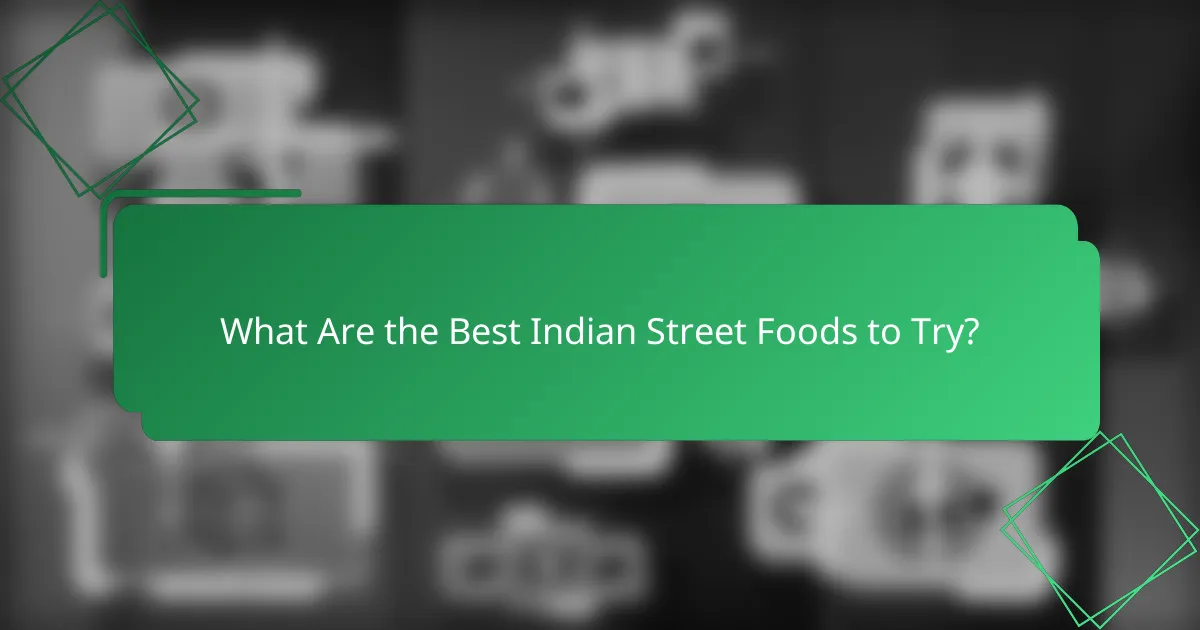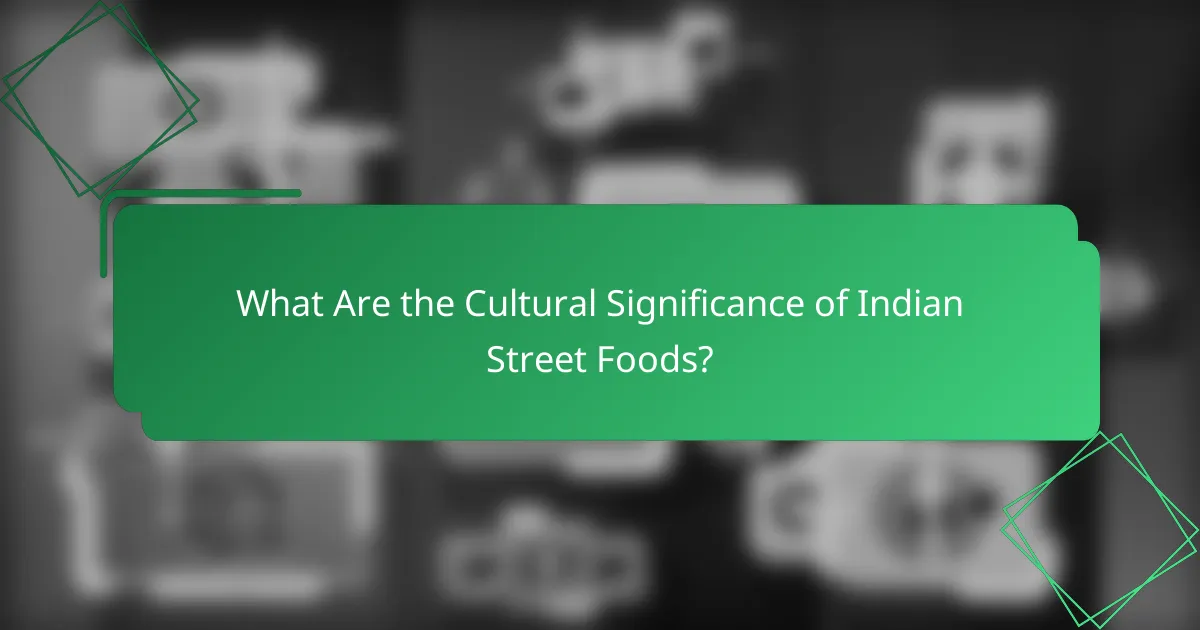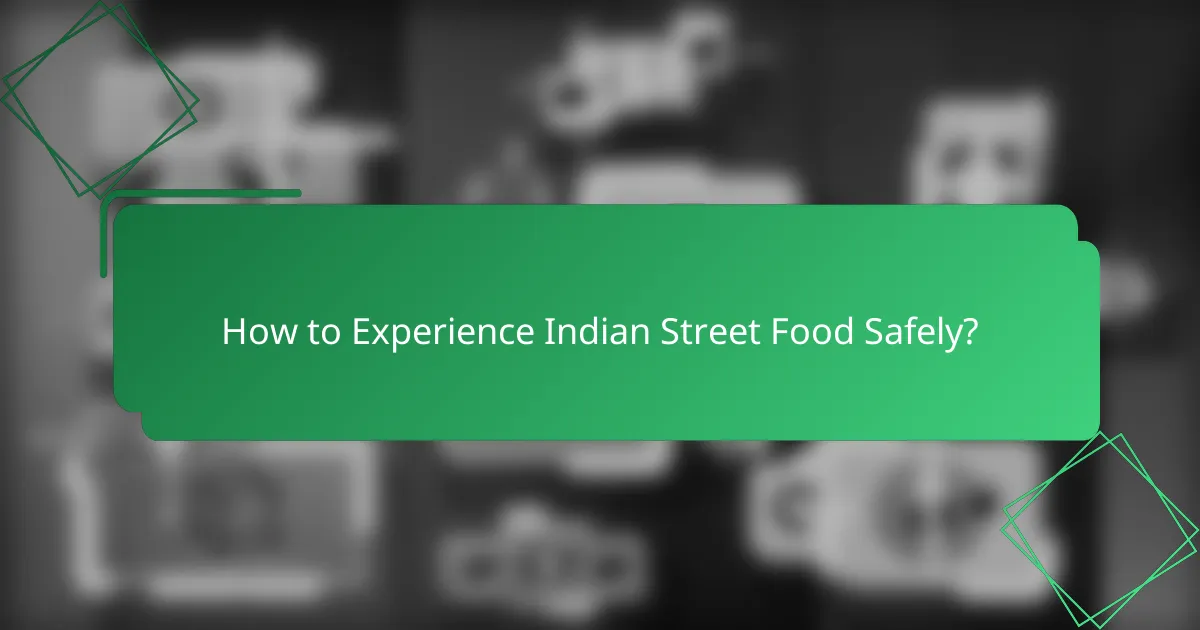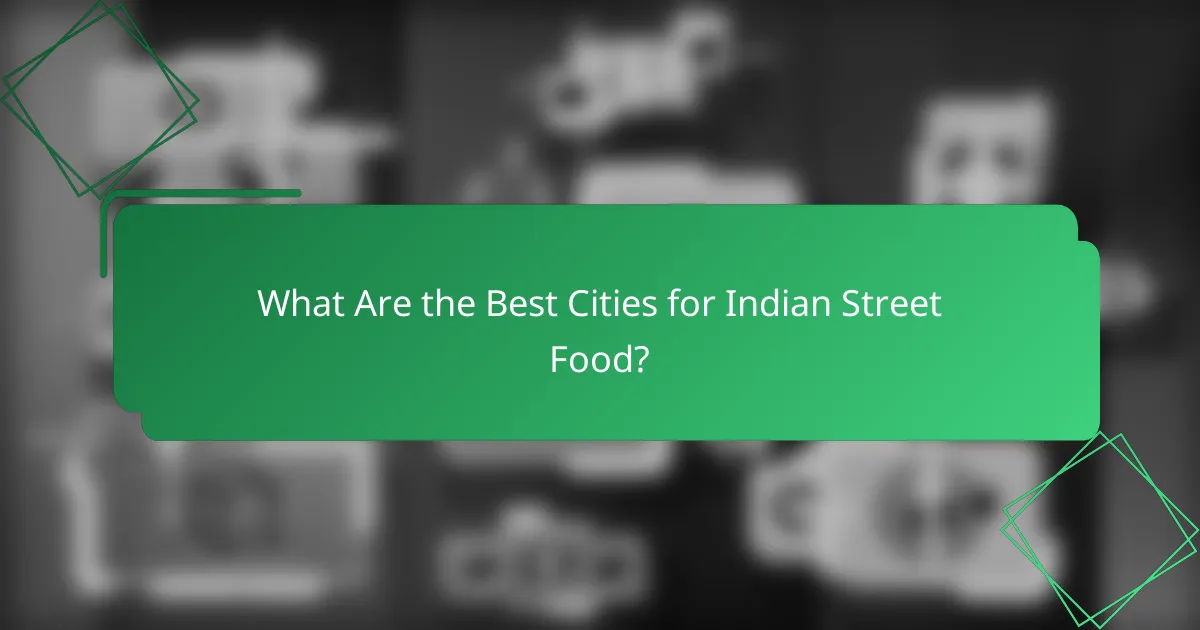Indian street food is a vibrant and essential part of the country’s culinary culture, showcasing a delightful array of flavors and textures. Each dish, from Pani Puri to Biryani, highlights the unique regional influences and ingredients that contribute to India’s rich gastronomic tapestry. These foods not only satisfy hunger but also foster social connections and celebrate local traditions.

What Are the Best Indian Street Foods to Try?
Indian street food is a vibrant aspect of the country’s culinary landscape, offering a variety of flavors and textures. Some of the best street foods to try include Pani Puri, Vada Pav, Chaat, Pakora, and Biryani, each representing unique regional influences and ingredients.
Pani Puri
Pani Puri is a popular street snack consisting of hollow, crispy puris filled with a spicy mixture of tamarind water, potatoes, and chickpeas. This dish is known for its burst of flavors, combining tangy, spicy, and sweet elements in each bite.
When enjoying Pani Puri, it’s best to eat them quickly after they are filled to maintain their crispiness. Look for vendors who prepare the puris fresh and serve them with a variety of flavored waters for a personalized experience.
Vada Pav
Vada Pav is often referred to as Mumbai’s burger, featuring a spicy potato fritter (vada) sandwiched between a soft bread roll (pav). It’s typically served with chutneys and fried green chilies, making it a flavorful and satisfying snack.
This dish is affordable and widely available, making it a staple for locals and tourists alike. For the best experience, try it from a renowned street vendor known for their unique chutney blends.
Chaat
Chaat encompasses a variety of savory snacks that are typically served at roadside stalls. Popular variations include Aloo Tikki Chaat and Bhel Puri, which combine ingredients like potatoes, chickpeas, yogurt, and various chutneys.
Chaat is characterized by its mix of textures and flavors, often featuring crunchy, tangy, and spicy elements. When ordering, consider trying a few different types to experience the full range of tastes.
Pakora
Pakora refers to deep-fried fritters made from vegetables, such as potatoes, onions, or spinach, coated in a spiced chickpea flour batter. They are crispy on the outside and soft on the inside, making them a perfect snack for any time of day.
Enjoy Pakoras with a side of mint chutney or tamarind sauce for added flavor. They are especially popular during the monsoon season, served hot and fresh from street vendors.
Biryani
Biryani is a fragrant rice dish layered with marinated meat or vegetables, spices, and sometimes saffron. While traditionally a main course, many street vendors serve it in smaller portions, making it accessible as a street food option.
When trying Biryani from street vendors, look for those that prepare it fresh daily. The best Biryani is often characterized by its rich aroma and the perfect balance of spices, so don’t hesitate to ask for recommendations from locals.

How Do Regional Flavors Influence Indian Street Food?
Regional flavors significantly shape Indian street food, reflecting the diverse culinary traditions across the country. Each region utilizes unique ingredients and cooking techniques, resulting in a rich tapestry of flavors that cater to local tastes and preferences.
North Indian Spices
North Indian street food is characterized by its bold and aromatic spices, such as cumin, coriander, and garam masala. Dishes like chaat and kebabs often feature these spices, enhancing their flavor profiles and making them irresistible to locals and tourists alike.
Street vendors in cities like Delhi and Amritsar frequently use these spices to create dishes that are both savory and spicy. For instance, the popular dish aloo tikki is seasoned with a mix of spices that elevate its taste, making it a favorite snack among street food enthusiasts.
South Indian Coconut Usage
Coconut is a staple ingredient in South Indian street food, adding richness and flavor to various dishes. From dosas to idlis, coconut is often used in chutneys and fillings, providing a unique taste that distinguishes Southern cuisine.
In cities like Chennai and Hyderabad, street vendors serve dishes like coconut rice and medu vada, which showcase the versatility of coconut. The use of fresh coconut enhances the overall flavor and texture, making these dishes a must-try for anyone exploring South Indian street food.
East Indian Sweets
East India is renowned for its delectable sweets, which play a significant role in its street food culture. Desserts like rasgulla and sandesh are popular among locals and are often enjoyed as a sweet treat after savory meals.
In Kolkata, street vendors offer a variety of sweets that highlight the region’s culinary heritage. The use of chhena (fresh cheese) in these desserts creates a unique texture and flavor, making them a delightful experience for those with a sweet tooth.
West Indian Snacks
West Indian street food is known for its diverse range of snacks, often featuring ingredients like chickpeas, potatoes, and various spices. Dishes such as pav bhaji and vada pav are staples in cities like Mumbai, showcasing the region’s love for bold flavors and textures.
Street vendors in this region often serve these snacks with a variety of chutneys and toppings, enhancing their taste and appeal. The combination of spices and fresh ingredients makes West Indian snacks a popular choice for those seeking a quick and flavorful bite on the go.

What Are the Cultural Significance of Indian Street Foods?
Indian street foods are deeply woven into the cultural fabric of the country, reflecting regional diversity and culinary traditions. They serve as a medium for social interaction, celebration, and the preservation of local flavors.
Community Gathering
Street food in India acts as a catalyst for community gathering, bringing people together from diverse backgrounds. Vendors often set up stalls in busy marketplaces, creating a vibrant atmosphere where friends and families can enjoy meals while socializing.
These communal spaces foster connections and interactions, often leading to spontaneous conversations and shared experiences. The accessibility of street food encourages participation from all social strata, making it a unifying force in urban and rural areas alike.
Festivals and Celebrations
During festivals, street food plays a pivotal role in cultural celebrations, offering traditional dishes that evoke nostalgia and heritage. Special items are often prepared for occasions like Diwali or Eid, showcasing regional specialties that vary across the country.
These foods not only satisfy hunger but also symbolize festivity and joy, enhancing the overall experience of the celebrations. For instance, sweet treats like jalebi during Diwali or biryani during Eid are integral to the festivities, reinforcing cultural identity.
Street Food Vendors’ Role
Street food vendors are essential to the culinary landscape of India, often serving as custodians of traditional recipes and cooking methods. They bring local flavors to the forefront, allowing people to experience authentic regional cuisines without the need for formal dining.
Many vendors have established loyal customer bases, contributing to the local economy and providing employment opportunities. However, they must adhere to health regulations to ensure food safety, which can vary by region, impacting their operations and reputation.

How to Experience Indian Street Food Safely?
To enjoy Indian street food safely, prioritize vendors that demonstrate good hygiene and food handling practices. Be mindful of what you eat, opting for freshly prepared items and observing local recommendations.
Choosing Reputable Vendors
Selecting reputable vendors is crucial for a safe street food experience. Look for stalls with a steady stream of customers, as this often indicates freshness and popularity. Vendors who are known for specific dishes tend to maintain quality and consistency.
Check for cleanliness around the food preparation area and ensure that the vendor uses gloves or utensils when handling food. Avoid stalls that appear dirty or have food exposed to dust and insects.
Understanding Hygiene Practices
Understanding hygiene practices can help you make informed choices. Vendors should follow basic food safety protocols, such as keeping raw and cooked foods separate and maintaining proper food temperatures. Familiarize yourself with local health standards, which can vary by region.
Look for signs of hygiene, such as the use of clean utensils and proper waste disposal. If you notice any red flags, such as unwashed hands or dirty cooking surfaces, it’s best to choose another vendor.
Local Recommendations
Local recommendations can guide you to safe and delicious street food options. Ask residents or fellow travelers for their favorite stalls, as they often know which vendors prioritize safety and quality. Online reviews and food blogs can also provide insights into reputable vendors in your area.
Consider visiting popular street food markets, where multiple vendors are present and competition encourages better hygiene practices. Engaging with locals can enhance your experience and help you discover hidden gems that are both safe and flavorful.

What Are the Best Cities for Indian Street Food?
The best cities for Indian street food are renowned for their vibrant culinary scenes, offering a variety of flavors and dishes that reflect local culture. Mumbai and Delhi stand out as top destinations, each showcasing unique street food experiences that attract both locals and tourists.
Mumbai
Mumbai is famous for its diverse street food, with iconic dishes like vada pav, pav bhaji, and bhel puri available at numerous stalls and carts throughout the city. The bustling streets of areas like Juhu Beach and Chowpatty are particularly popular for sampling these local delights.
When exploring Mumbai’s street food, consider visiting during the evening when vendors are most active. Always check for cleanliness and opt for stalls with a high turnover of customers to ensure freshness. A budget of around 200-500 INR (approximately 2-6 USD) can provide a satisfying meal.
Delhi
Delhi’s street food scene is equally impressive, featuring dishes such as chaat, kebabs, and parathas that reflect the city’s rich culinary heritage. Areas like Chandni Chowk and Connaught Place are hotspots for food lovers, offering a wide range of flavors and textures.
To fully enjoy Delhi’s street food, try to visit during the cooler parts of the day, as many vendors operate in the evening. Look for stalls that are busy and have a reputation for quality. A meal can typically cost between 100-400 INR (around 1-5 USD), making it an affordable option for anyone looking to indulge in local cuisine.
